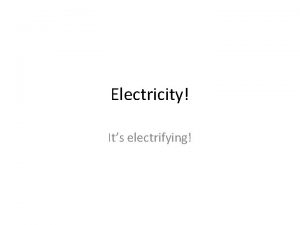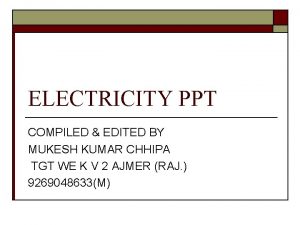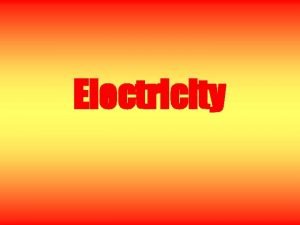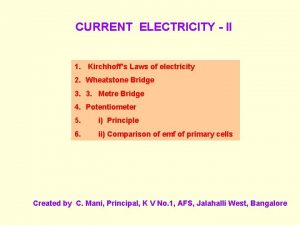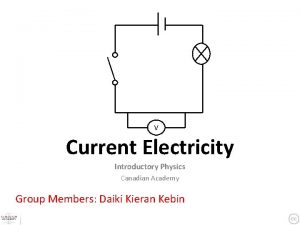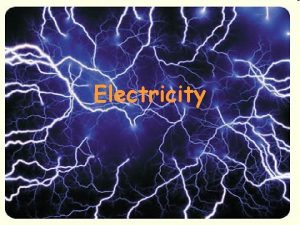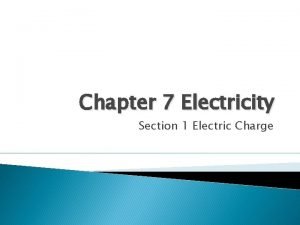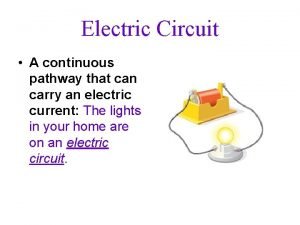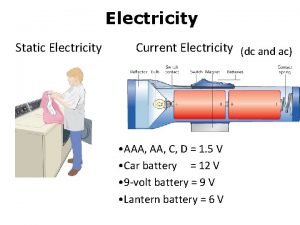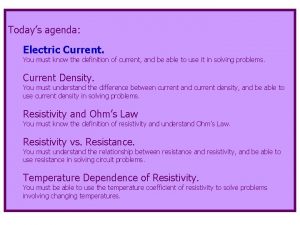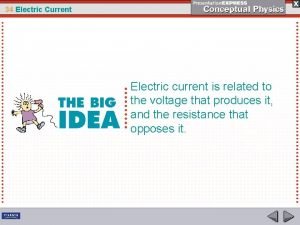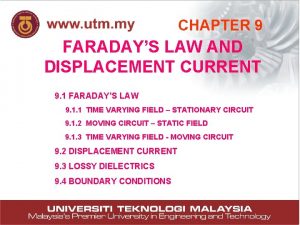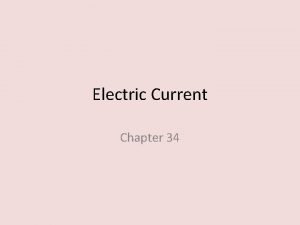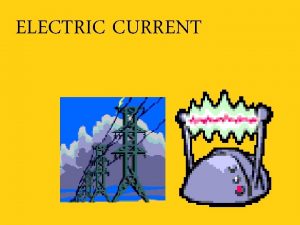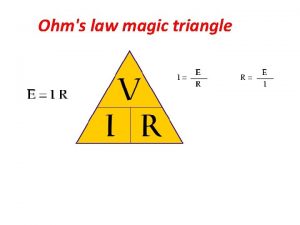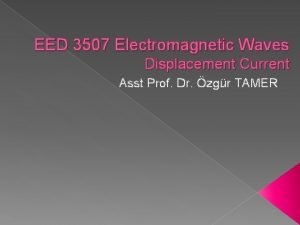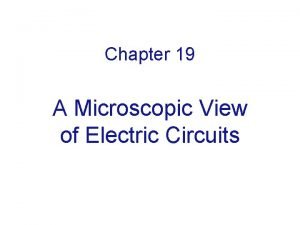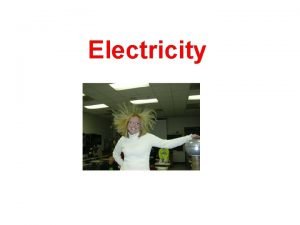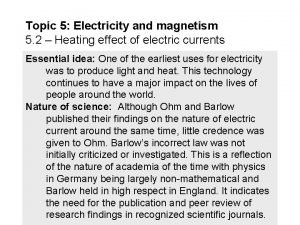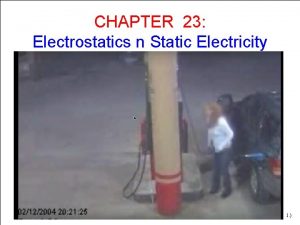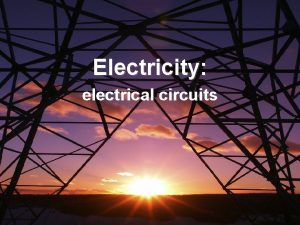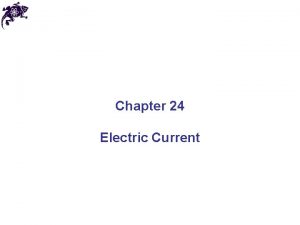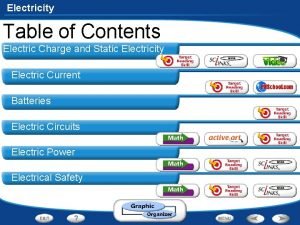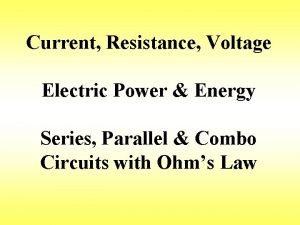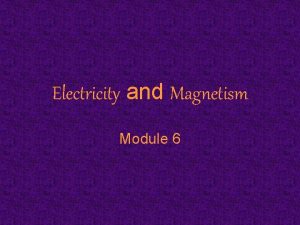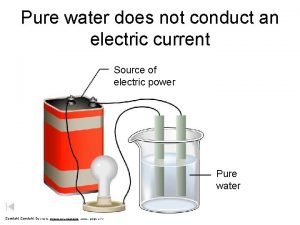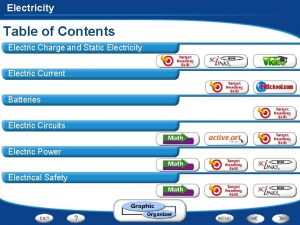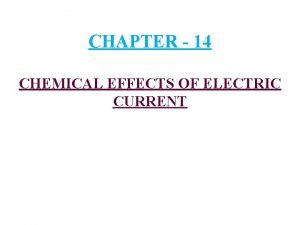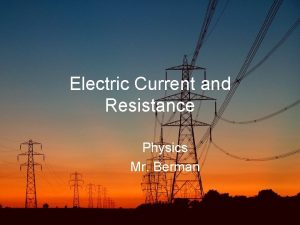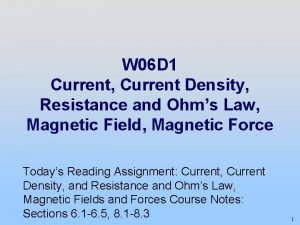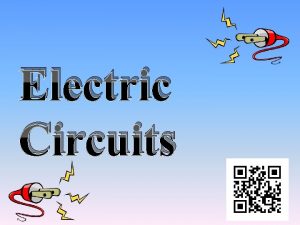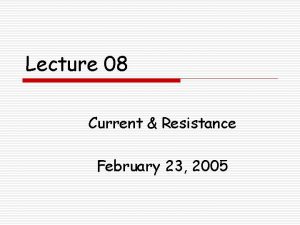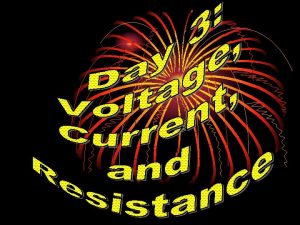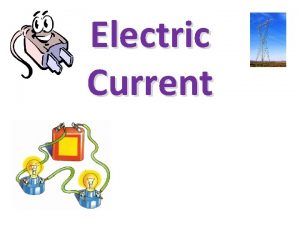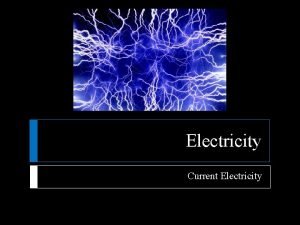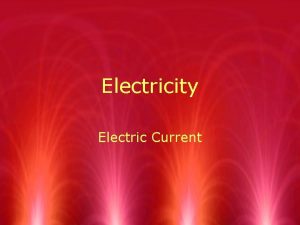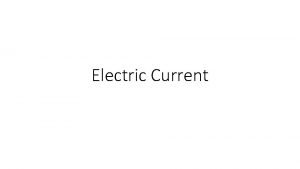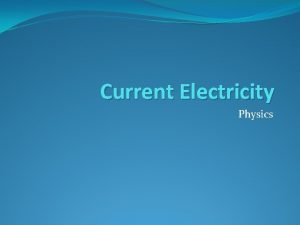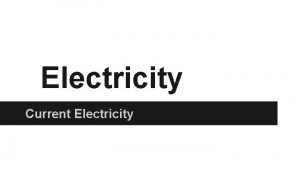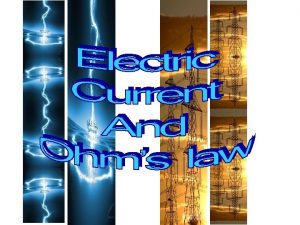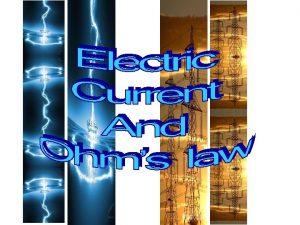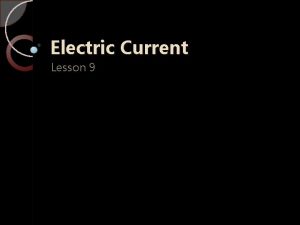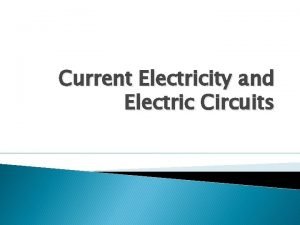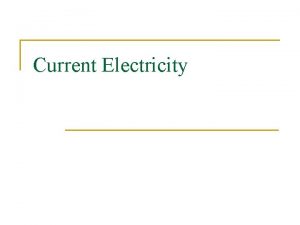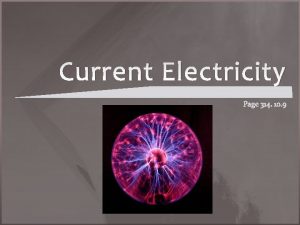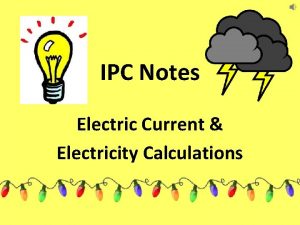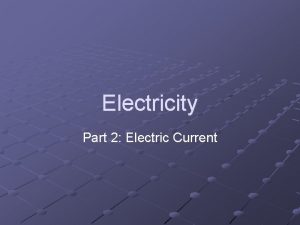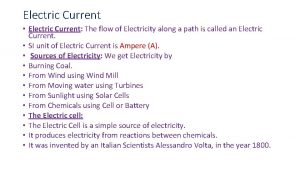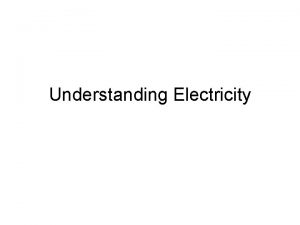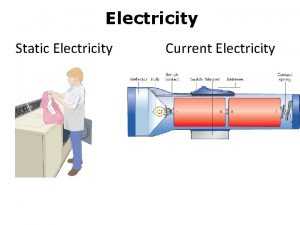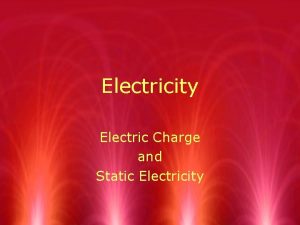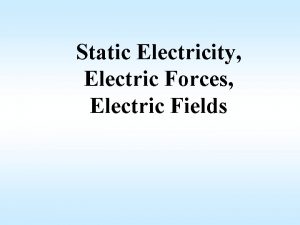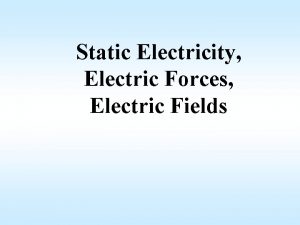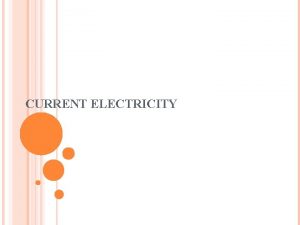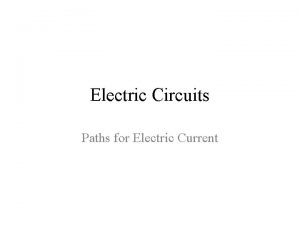05032021 Electricity Electric Current Electric current is a


































































- Slides: 66

05/03/2021 Electricity

Electric Current Electric current is a flow of negatively charged particles (i. e. electrons). We call them “charge carriers” + e- - e- 05/03/2021 Note that electrons go from negative to positive

Conventional Current 05/03/2021 As we said, technically electrons go from negative to positive. However, we usually talk about “conventional current” and we say that current moves from positive to negative: + -

Basic ideas… 05/03/2021 Electric current is when electrons start to flow around a circuit. We use an _____ to measure it and it is measured in ____. Potential difference (also called _______) is how big the push on the electrons is. We use a ____ to measure it and it is measured in ______, a unit named after Volta. Resistance is anything that resists an electric current. It is measured in _____. Words: volts, amps, ohms, voltage, ammeter, voltmeter

More basic ideas… 05/03/2021 If a battery is added the current will ____ because there is a greater _____ on the electrons so they move ______ If a bulb is added the current will _______ because there is greater ____ in the circuit, so the electrons move _____ Words – faster, decrease, slower, increase, push, resistance

DC and AC revision 05/03/2021 V DC stands for “Direct Current” – the current only flows in one direction: Time 1/50 th s AC stands for “Alternating Current” – the electrons change direction 50 times every second (frequency = 50 Hz) 240 V T V

Charge and Current 05/03/2021 Recall the structure of an atom: PROTON – positively charged ELECTRON – negatively charged Notice: 1) Atoms have the same number of protons and electrons – they are NEUTRAL overall 2) Because electrons are on the outside of the atoms they can move around (this is what causes electrical effects)

Measuring Charge 05/03/2021 The charge on an electron is very small, so we measure charge using units called “coulombs” (C). One electron has a charge of 1. 6 x 10 -19 C. Charge can be measured using a coulombmeter, and they usually measure in nanocoloumbs (1 n. C = 10 -9 C). For example, a charged polythene rod may carry a charge of a few hundred nanocoulombs

Calculating Charge (Q) 05/03/2021 By definition, current is the rate of flow of charge. In other words, its how much charge flows per second. One amp (1 A) is equal to one coulomb per second (1 Cs-1). Charge and current are related by the equation: Current = rate of flow of charge I = ΔQ Δt 1. A battery supplies 10 C over a period of 50 seconds. What is the current? 2. Another battery is connected for 2 minutes and provided a current of 0. 4 A. How much charge flowed? 3. A car battery has a capacity of 24 Ah (amp hours). If it provides a current of 48 A how long can it be used for? How much charge (in coulombs) does it contain?

Current in a series circuit 05/03/2021 If the current here is 2 amps… The current here will be… And the current here will be… In other words, the current in a series circuit is THE SAME at any point (this is because the charge in the circuit must be conserved).

Current in a parallel circuit 05/03/2021 A PARALLEL circuit is one where the current has a “choice of routes” Here comes the current… Half of the current will go down here (assuming the bulbs are the same)… And the rest will go down here…

Current in a parallel circuit 05/03/2021 If the current here is 6 amps And the current here will be… The current here will be…

Some example questions… 05/03/2021 3 A 6 A

Voltage 05/03/2021 Earlier on we said that current is when electrons move: + - e- “Voltage” is the force that- pushes the electrons. For e electrons to move there must be a “voltage difference”, sometimes called a “potential difference” (p. d. ). A higher p. d. means a stronger push, which causes an increase in current.

Work done 05/03/2021 Definition of a volt: The voltage between two points is the work done per coulomb travelling between the two points Voltage = work done charge V=W Q We can see that 1 V = 1 JC-1 Q. What is a volt in base units?

Example Questions 05/03/2021 1) A battery does 9 J of work. If it transfers 6 C of charge what is the battery’s voltage? 2) A powerpack does 100 J of work in transferring 20 C of charge. What is the voltage? 3) A 9 V battery transfers 20 C of charge. How much work did it do? 4) If the current of the battery is 0. 2 A how long was it used for? 5) 240 J of work is done to a 12 V motor. How much charge flowed through it? 6) If this motor was used for 40 seconds how much current did it draw?

Voltage in a series circuit 05/03/2021 If the voltage across the battery is 6 V… V …and these bulbs are all identical… …what will the voltage across each bulb be? V V 2 V

Voltage in a series circuit 05/03/2021 If the voltage across the battery is 6 V… V …what will the voltage across two bulbs be? 4 V V In other words, voltage “splits up” in a series circuit. This is because the energy is conserved.

Voltage in a parallel circuit 05/03/2021 If the voltage across the batteries is 4 V… What is the voltage here? 4 V V And here? V 4 V

Summary 05/03/2021 In a SERIES circuit: Current is THE SAME at any point Voltage SPLITS UP over each component In a PARALLEL circuit: Current SPLITS UP down each “strand” Voltage is THE SAME across each”strand”

An example question: 6 V A 3 3 A A 1 V 1 A 2 V 3 05/03/2021

Another example question: 05/03/2021 10 V A 3 3 A A 1 V 1 A 2 V 3

Using voltmeters and ammeters 05/03/2021 A V The resistance of an ammeter is assumed to be VERY SMALL – this ammeter will only have a very small voltage across it. This is why you can connect it in SERIES. The resistance of a voltmeter is assumed to be VERY LARGE, so only a small current will go through it. This is why you connect it in PARALLEL.

Resistance 05/03/2021 Resistance is anything that will RESIST a current. It is measured in Ohms, a unit named after me. Georg Simon Ohm 1789 -1854 The resistance of a component can be calculated using this equation: Resistance (in ) = V Voltage (in V) Current (in A) I R

An example question: 05/03/2021 Ammeter reads 2 A A V Voltmeter reads 10 V 1) What is the resistance across this bulb? 2) Assuming all the bulbs are the same what is the total resistance in this circuit?

More examples… 05/03/2021 3 A 6 V 12 V 3 A 2 A 4 V 2 V 1 A What is the resistance of these bulbs?

Resistance 05/03/2021 Resistance is anything that opposes an electric current. Resistance (Ohms, ) = Potential Difference (volts, V) Current (amps, A) What is the resistance of the following: 1) A bulb with a voltage of 3 V and a current of 1 A. 2) A resistor with a voltage of 12 V and a current of 3 A 3) A diode with a voltage of 240 V and a current of 40 A 4) A thermistor with a current of 0. 5 A and a voltage of 10 V

Ohm’s Law 05/03/2021 Ohm’s Law is a special case where voltage is proportional to current. For example, consider a resistor: I R V Current increases in proportion to voltage Georg Simon Ohm 1789 -1854 V Resistance stays constant This is usually only the case if temperature stays constant.

Resistors in Series I R 1 05/03/2021 “In a series circuit current stays the same but voltage splits up” V 1 VT = V 1 + V 2 VT = IRT VT R 2 V 2 But V 1 = IR 1 and V 2 = IR 2 IRT = IR 1 + IR 2 RT = R 1 + R 2

Resistors in Parallel IT I 1 “In a parallel circuit voltage stays the same but current splits up” IT = I 1 + I 2 IT = V R 1 R 2 RT V V = V + V RT IT 05/03/2021 R 2 1 = 1 + 1 RT R 1 R 2

Example questions 05/03/2021 Calculate the equivalent resistance: 1) 40Ω 10Ω 2) 20Ω 10Ω 3) 100Ω 20Ω 4) 100Ω 50Ω

Electrical Power Voltage = work done 1) Recall: charge 2) Also, recall that power = rate of doing work 3) Therefore 4) But I = Q so T 5) Again, E=Pt, so Power = work done time 05/03/2021 W = QV P=W T Power = charge x voltage P = Q x V time Power = current x voltage Work done = current x voltage x time T P = IV W = It. V

Power through a resistor 05/03/2021 Recall: 1) P = IV Putting these two equations together gives us: 2) V = IR Power = I x IR = I 2 R or V 2/R 1) A 10Ω resistor has 2 A flowing through it. Calculate the power dissipated by the resistor. 2) A motor takes a current of 10 A. If its resistance is 2. 2 MΩ calculate the power dissipated by the motor. 3) A 2 KW heater has a resistance of 20 Ω. Calculate the current through it.

Current-Voltage Graphs Voltage on powerpack/V 12 10 … -10 -12 Current/A 05/03/2021 Voltage/V

Current-voltage graphs 05/03/2021 Consider a resistor: I R V Current increases in proportion to voltage – an “Ohmic conductor” V Resistance stays constant

Current-voltage graphs 05/03/2021 Now consider a bulb: I R V As voltage increases the bulb gets hotter and resistance increases V Resistance increases as the bulb gets hotter

Current-voltage graphs Now consider a diode: 05/03/2021 Now consider a thermistor: I I V A diode only lets current go in the “forward” direction V Resistance decreases as the (“negative-temperaturecoefficient”) thermistor gets hotter

Electron Drift 05/03/2021 What happens inside a conducting material? The following model of a metal wire could help: Electrons Ions At normal temperatures, with no current flowing, electrons hurtle around continuously. They collide with ions but because their movement is random there is no net energy transfer.

Electron Drift 05/03/2021 Now apply a voltage: Negative Electrons Ions Positive This time we can see that the electrons are accelerated from negative to positive. This movement is superimposed on top of the random velocities and is responsible for electrical effects.

Understanding Resistance 05/03/2021 1) Increase length 2) Increase area 3) Decrease resistivity Therefore Resistance = resistivity x length area R = ρL A

Resistivity 05/03/2021 The resistance of a wire depends on 3 things: the length of the wire, the width of the wire and what the wire is made of: Resistance = resistivity x length area R = ρL A Calculate the following: 1) The resistance of a copper wire of length 2 m, area 2 mm 2 and resistivity 1. 7 x 10 -8 Ωm 2) The resistance of an iron wire of length 100 m, area 5 mm 2 and resistivity 1 x 10 -7 Ωm 3) A copper wire has a resistance of 5Ω. If the wire is 20 m long and the wire is cylindrical what is the radius of the wire?

Carrier Density Consider a copper atom: 05/03/2021 The diameter of a copper atom is about 0. 25 nm This means that there will be 1 / 0. 25 nm = 4 x 109 copper atoms in 1 metre. Consider a copper cube of sides 1 m: Theoretically , in this cube there must be (4 x 109)3 = 6. 4 x 1028 copper atoms. Assuming each atom has one free electron there are 6. 4 x 10 28 free charges per cubic metre – this is called the “charge carrier density” (n)

Some questions… 05/03/2021 1) If, for copper, n = 6. 4 x 1028 and each electron has a charge of 1. 6 x 10 -19 C how much free charge was in the cubic metre? 2) How much free charge would be in 1 mm 3 instead? 3) Calculate the carrier density for a cubic metre of another atom with diameter 0. 3 nm. Assume each atom has one free electron again.

Drift Speed 05/03/2021 Definition: Drift speed is the speed with which electrons will move down a wire. How do we work it out? Consider a wire of cross sectional area A and charge carrier density n, where each carrier has the charge q and they are moving with a drift speed of v. 1) Every second the volume of charge carriers that pass a point will be Av 2) Therefore the number of charge carriers that pass by every second is given by n. Av 3) Therefore the charge that passes by every second will be n. Avq 4) But charge per second IS current, so… I = n. Aqv

Example questions 05/03/2021 1) Calculate the current down a 1 mm 2 wire where the drift speed is 1 mms-1 and the carrier density is 6. 4 x 1028 m-3 (remember that the charge on an electron is 1. 6 x 10 -19 C) 2) Calculate the drift speed down a 2 mm 2 wire which has a current of 0. 5 A passing through it and a carrier density of 6. 4 x 1028 m-3.

This seems slow… 05/03/2021 The drift speeds in the previous questions seemed very slow – why is it that when you turn on a light bulb it lights straight away then? Consider the electrons in the wire: Bulb Battery When an electron is pushed in it knocks on the others so that electrons “come out” at the other end. Simple really…

Comparing Drift Speeds 05/03/2021 Consider two wires connected in series: 1 2 Q. The area of wire 2 is twice that of wire 1. Which wire do electrons travel fastest in? In wire 1 I 1 = n 1 A 1 q 1 v 1 In wire 2 I 2 = n 2 A 2 q 2 v 2 However, in series I 1=I 2 therefore n 1 A 1 q 1 v 1 = n 2 A 2 q 2 v 2 Also, q 1 = q 2 and n 1 = n 2… Therefore A 1 v 1 = A 2 v 2

Two simple semiconductors: 05/03/2021 1) Light dependant resistor – resistance DECREASES when light intensity INCREASES Resistance 2) Thermistor – resistance DECREASES when temperature INCREASES Resistance Amount of light Temperature

Understanding Current Recall the equation: 05/03/2021 Increasing the temperature of a metal will increase the ______ of the ions. This will increase the ____ of the metal and decrease the current because it lowers the _____. I = n. Aqv In semiconductors the carrier density is small but _____ with temperature, so the resistivity of a semiconductor decreases with temperature (e. g. a ____). In insulators n is very low. Words – thermistor, resistivity, vibrations, drift speed, increases

Explaining changes to n and v 05/03/2021 Normal conductor: Now increase the temperature: • Ion vibrations increase • Drift velocity decreases • I = n. Aqv, so current decreases

Explaining changes to n and v 05/03/2021 Consider an LDR: Now increase the amount of light: • More charge carriers • n is higher • I = n. Aqv, so current increases

Voltage at a point Consider 4 batteries in series: The voltage here is 6 V The voltage here is 4. 5 V The voltage here is 3 V The voltage here is 1. 5 V Take this point as being 0 V 05/03/2021

Voltage at a point 05/03/2021 Now put these batteries into a circuit: The voltage here is 6 V The voltage here is 0 V This means that, as we move around the wire, the voltage should do this: Potential 6 Distance from terminal

Potential Dividers 05/03/2021 VIN R 1 VOUT R 2 0 V 0 V The Potential Divider equation: VOUT VIN (R 2) x (R 1 + R 2)

Some example questions 12 V 50 V 100 0 V 10 VOUT 0 V 3 V 75 0 V VOUT 0 V 1. 5 V 75 25 0 V 05/03/2021 50 VOUT 0 V 45 0 V VOUT 0 V

Practical applications Here’s a potential divider that is used to control light-activated switches… 05/03/2021 Vin VOUT 0 V When the light intensity on the LDR decreases its resistance will ____. This causes VOUT to _______ so the output device will probably turn _____. The variable resistor can be adjusted to change the ____ of the whole device. Words – decrease, sensitivity, increase, off

An example Calculate the missing values (from June 2006) 6 V A ? 4Ω ? ? R A ? V 15Ω 0. 24 A A 05/03/2021

More examples 05/03/2021 ? 18 V ? ? ? 0. 5 A 10Ω 20Ω A 10Ω ? 40Ω 18 V ? ? ?

Electromotive force and p. d. 05/03/2021 Components like batteries and power supplies provide a force that pushes the current around a circuit: we call this the “electromotive force” (e. m. f). Other components like bulbs and motors have work done to them by the current – the voltage across them is called the “potential difference” (p. d. ) The sum of these EMFs… Definition of EMF – “the total work done by a cell per coulomb of charge” Is equal to the sum of the p. d. s

Internal Resistance + 05/03/2021 - V The voltage across the terminals of a battery is called the “terminal p. d. ”

Internal Resistance + 05/03/2021 - V This voltage DECREASES when more components are added…

Internal Resistance 05/03/2021 All sources of EMF behave as though they have a “built-in” resistor. This is called the “internal resistance” and can be thought of as the resistance to the flow of current inside the power supply itself. V It’s useful to think of the internal resistance as part of the external circuit.

Short Circuit Current 05/03/2021 In this “short circuit” the only significant resistance is the internal resistance, so… Current = EMF Internal resistance Usually power supplies should have low internal resistances. However, high voltage supplies can have large resistances to avoid supplying too much current.

Numerical quiz 05/03/2021 1) What is the resistance of a bulb with a voltage of 12 V and a current of 2 A through it? 2) This bulb transfers 100 C of electrical energy. How long was it used for? 3) A power supply does 4, 800 J of work. If it transfers 20 C of charge what is the EMF of the supply? 4) What is the resistance of a thermistor when the p. d. across it is 20 V and the current through it is 2 A? 5) Work out the total resistance of the following: 10Ω each 20Ω each

Numerical quiz 05/03/2021 6) A thermistor has a resistance of 200 when 20 V is applied across it. What is the current through thermistor? 7) The same thermistor is put in a warm water bath. The resistance drops to 120. What is the current through it now? 8) A resistor takes a current of 2 A. If the resistor has a resistance of 10Ω calculate the power dissipated in the resistor. 9) A piece of copper wire has a length of 2 m, an area of 1 mm 2 and a resistivity of 1. 7 x 10 -8Ωm. Calculate the resistance. 10) Calculate the charge carrier density in this wire if the drift speed is 1 mms-1 and the current through it is 2 A.

Numerical quiz 05/03/2021 11) How many electrons does it take to have a charge of 20 C? 12) A bulb dissipates 800 W of power. If its resistance is 200Ω calculate the current through it. 13) What is the voltage across this bulb? 14) An electric fire uses 1200 C of charge over 2 minutes. What current did it draw? 15) Calculate the following output voltages: 12 V 20 V 50 150 0 V 4 VOUT 0 V 6 0 V VOUT 0 V
 Static electricity and current electricity
Static electricity and current electricity Static electricity and current electricity
Static electricity and current electricity Magnetism vocabulary
Magnetism vocabulary 05032021
05032021 05032021
05032021 Current electricity def
Current electricity def Current electricity ppt
Current electricity ppt Bill nye static electricity
Bill nye static electricity Venn diagram series and parallel circuits
Venn diagram series and parallel circuits What is energy made of
What is energy made of Current electricity
Current electricity Difference between charge and electric charge
Difference between charge and electric charge What is current electricity in physics
What is current electricity in physics Electricity section 1 electric charge
Electricity section 1 electric charge Chapter 6 section 1 electric charge worksheet answers
Chapter 6 section 1 electric charge worksheet answers Electricity section 1 electric charge
Electricity section 1 electric charge Chapter 3 shielded metal arc equipment setup and operation
Chapter 3 shielded metal arc equipment setup and operation Ac theory 3 lesson 4
Ac theory 3 lesson 4 In a delta connected source feeding a y connected load
In a delta connected source feeding a y connected load Line current and phase current
Line current and phase current Hazard based safety engineering
Hazard based safety engineering Drift current and diffusion current in semiconductor
Drift current and diffusion current in semiconductor Slideplayer
Slideplayer Line current and phase current
Line current and phase current Non planar circuit
Non planar circuit Intrinsic semiconductor
Intrinsic semiconductor Diffusion current density
Diffusion current density Drift current and diffusion current
Drift current and diffusion current The constant current region of a fet lies between
The constant current region of a fet lies between Pathway for carrying an electrical current.
Pathway for carrying an electrical current. Chapter 20 electric circuits
Chapter 20 electric circuits Ohm's law unit
Ohm's law unit Definition of electric current
Definition of electric current Electric current
Electric current Electric displacement current
Electric displacement current Maxwell equation for time varying field
Maxwell equation for time varying field Chapter 34 electric current
Chapter 34 electric current Electric current is the movement of
Electric current is the movement of Current electric field
Current electric field Ohms law triange
Ohms law triange Maximum displacement current
Maximum displacement current Microscopic view of current
Microscopic view of current Resistance is the opposition to
Resistance is the opposition to How do electric motors work
How do electric motors work Electric current is generated due to
Electric current is generated due to Heating effect of electric current
Heating effect of electric current Conceptual physics chapter 23 electric current
Conceptual physics chapter 23 electric current Rope loop model electricity
Rope loop model electricity ö
ö Chapter 24
Chapter 24 Static electricity
Static electricity How to find i total in a parallel circuit
How to find i total in a parallel circuit Nature of
Nature of Strong electric current
Strong electric current Electric current
Electric current Normal range sodium
Normal range sodium Electric current graphic organizer
Electric current graphic organizer Why is led or compass needle used in tester sometime
Why is led or compass needle used in tester sometime Units of electric current
Units of electric current A closed path that electric current follows is a(n) ______.
A closed path that electric current follows is a(n) ______. J=nqv
J=nqv Fusao
Fusao Water electric current
Water electric current Chapter 23 electric current circuit happenings
Chapter 23 electric current circuit happenings Def voltage
Def voltage What is electrical current? *
What is electrical current? * Electric current is defined as
Electric current is defined as





